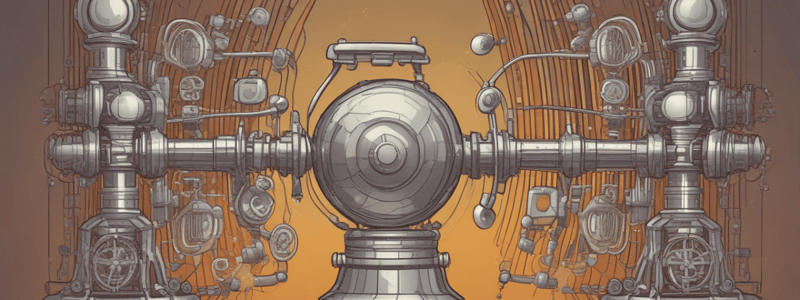Podcast
Questions and Answers
What is the primary purpose of fluorine-18 in PET scanning?
What is the primary purpose of fluorine-18 in PET scanning?
- To enhance the image quality
- To increase the scanning time
- To attach to a glucose molecule and reveal cancerous cells (correct)
- To reduce radiation exposure to the patient
What is the result of the positron emission decay in PET scanning?
What is the result of the positron emission decay in PET scanning?
- The production of X-rays
- The creation of scattered radiation
- The emission of high-energy photons
- The generation of oppositely traveling annihilation photons (correct)
What is the purpose of a PET/CT scanner?
What is the purpose of a PET/CT scanner?
- To produce high-quality X-ray images
- To combine functional and anatomical imaging modalities (correct)
- To increase the scanning time
- To reduce radiation exposure to the patient
What is a primary concern for radiation safety in PET/CT scanners?
What is a primary concern for radiation safety in PET/CT scanners?
Why is shielding necessary in PET/CT scanners?
Why is shielding necessary in PET/CT scanners?
What is the role of fluorodeoxyglucose (FDG) in PET scanning?
What is the role of fluorodeoxyglucose (FDG) in PET scanning?
What is a consideration for radiation protection in PET/CT scanners?
What is a consideration for radiation protection in PET/CT scanners?
What is the advantage of a well-designed facility for PET/CT scanners?
What is the advantage of a well-designed facility for PET/CT scanners?
What is the purpose of shielding in a PET/CT scanner facility?
What is the purpose of shielding in a PET/CT scanner facility?
Flashcards are hidden until you start studying
Study Notes
Isotopes
- Atoms with the same number of protons in the nucleus but different numbers of neutrons
- Most elements in the periodic table have associated isotopes, but not all nuclei of these isotopes represent stable configurations of protons and neutrons
Radioisotopes
- Isotopes of a particular element that are unstable due to their neutron-proton configuration
- Radioisotopes can spontaneously undergo changes or transformations to rectify the unstable arrangement
- Half-life (HL) is the time taken for the radioactivity to decrease by half
Medical Usage
- Radiation therapy: uses high-energy radiation to kill cancer cells or shrink tumors
- Well-oxygenated, rapidly dividing cells are sensitive to radiation damage
- Radiation can be delivered internally through infusion or implantation of radioisotopes
Radiation Therapy
- Therapeutic isotopes have long half-lives and high-energy radiation
- Radiation can be in the form of gamma rays or fast electrons (beta radiation)
- Iodine-125 (125I) is a commonly used therapeutic radioisotope
- 125I seeds are used to treat prostate cancer, with a treatment goal of delivering 145 Gy to at least 90% of the prostate volume
- Radiation safety practices include distance and time
Radiation Therapy (Cont.)
- Iodine-131 (131I) is another commonly used therapeutic radioisotope
- 131I has a half-life of 8 days and can be joined chemically with sodium to form a radioactive compound
- 131I is used to treat thyroid cancer and residual thyroid tissue after surgery
- Personnel radiation protection considerations include distance, time, and shielding
Nuclear Medicine
- Employs radioisotopes to study organ function, detect cancer spread, and treat disease
- Diagnostic techniques use short-lived radioisotopes as tracers
- Common radioisotopes used in nuclear medicine include Iodine-123 (123I) and Technetium-99m (99mTc)
Nuclear Medicine (Cont.)
- 123I is used to study thyroid gland function and has an average half-life of 13.3 hours
- 99mTc is the most commonly used radioisotope in nuclear medicine and is produced from the radioactive decay of Molybdenum-99 (99Mo)
- 99mTc can be incorporated into various compounds or biologically active substances for different tissues or organs
Positron Emission Tomography (PET) and Computed Tomography (CT)
- PET uses annihilation radiation events from the radioactive decay of unstable isotopes
- Annihilation radiation is initiated by the radioactive decay of an unstable isotope with too many protons
- Positron-emitter isotopes, such as Fluorine-18 (18F), are used in PET scanning
- 18F can be attached to a glucose molecule to form fluorodeoxyglucose (FDG), a radioactive tracer taken up by cancerous cells
PET and CT (Cont.)
- PET/CT scanners combine the functional information from PET with the anatomical information from CT
- PET scanning is an important imaging modality for detecting and monitoring cancer
- Fluorodeoxyglucose (FDG) is used to reveal the location of cancerous cells through PET scanning
Radiation Protection
- Radiation safety shielding considerations for PET/CT scanners include scattered radiation, high-energy annihilation photons, and patient prep time
- Necessary protection for technologists and personnel includes distance, time, and shielding
- A well-designed facility with necessary shielding is essential for radiation protection
Studying That Suits You
Use AI to generate personalized quizzes and flashcards to suit your learning preferences.




